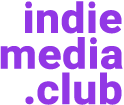Preparing a media kit is like telling a story. It should have a beginning (company introduction), middle (metrics), and end (rate card). It should have a hero (your brand) and a villain (the problem your partners are facing). There might even be some world-building (your future editorial calendar) and lore (success stories, testimonials)! Put it all together and you can weave a fantastic tale that will convince even the most Scrooge-like advertisers to buy-in.
Let’s face it if you can’t tell a good brand story—you can’t attract advertisers. I’m going to break down the purpose of a media kit as a whole and then dive into the role each element plays.
In the digital media age, it’s hard to stand out from the crowd. Millions of people are hoping their blog or social media account will gain enough of a following to attract paid advertisements. That’s where a digital media kit comes in. This article will cover all the basics of what a media kit is, why you need one, and how to use it.
- What Is A Media Kit?
- Importance Of A Media Kit
- Publisher Media Kit Must-Haves
- How To Use A Media Kit
What Is A Media Kit?
A media kit is a marketing tool. It showcases your brand identity and the media space you have for sale, along with pricing options and metrics that show why an advertiser should buy-in. A media kit demonstrates your value as a partner—it shows an advertiser the audience they’ll have access to if they buy space on your website or page.
It should have a flare of personality, too—is your brand trendy, innovative, elegant, serious, youthful, headstrong? This helps communicate your fit to certain advertisers.
Most advertisers don’t want to sell to just anyone. They are going to have questions about your audience demographics—like location, gender, age-range—and the more specific you can get for them, the better.
I worked for a high-end indie magazine in Vancouver and we went as far as to poll our readership using an IPSOS survey in exchange for a free subscription extension. From this, we gathered data about income range, hobbies, and even purchasing habits (automobiles, vacation packages, artwork). This was a hugely successful initiative! Our advertisers loved knowing nitty-gritty details about our readers and this was something we offered that many of our competitors could not.
An alternative solution is to use a tool like Quantcast or Similarweb - they'll run a script on your site to give you a ton of audience demographic insights.
Another thing you’re going to want to get into is reach and engagement. How many readers do you have? What is your follower count on the various social media sites? What are your newsletter open rates? What is your average click-through rate (CTR) on ads? Do you have conversion statistics for other products for whom you’ve advertised? What type of advertisements do you offer?
You need to be able to back up your claims, too. Set up a shareable dashboard using Google Analytics and be ready to pass on the link to anyone that asks. Not all advertisers will want to see (or will even understand) the base data but you should have it ready to go.
Differences Between A Press Kit And A Media Kit
There’s a lot of confusion out there about the difference between a media kit and a press kit. Many people talk about them like they’re interchangeable terms, but they’re not.
A press kit is made for journalists and other writerly folks. A media kit is made for advertisers or potential paying partners.
A press kit includes all the necessary information someone would need to write about your brand for a press release or similar informational content. This is your bio, your contact information, links to your social media and website, photos, and any other important brand resources.
The most confusing part is that if someone talks about a corporate or company media kit, it could also (and probably does) mean a press kit or an internal style guide. Large companies use the term “corporate media kit” to mean a) something they provide to journalists and other news-circulating websites, or b) a guideline for how to talk about or represent the company in outward-facing communications.
Importance Of A Media Kit
Advertisers partner with content creators because they want access to their audience. For example, a makeup brand would want to partner with an influencer who posts about makeup, because an audience that enjoys that content will also likely be interested in buying makeup.
- A media kit neatly displays all the information potential advertisers want to know, like your audience demographics. This will help them decide if advertising with you will bring in a significant return on investment. If an advertiser doesn’t have the same target audience as you, then there’s no point in them buying your media space.
- It’s also a mark of professionalism. Clearly communicating your value and offerings with a good media kit shows potential advertisers that you will be easy to work with.
Even huge brands have media kits. Some, like Forbes, are simple one-page documents, while others like Glamour have separate sections for each of their markets.
These sites are great media kit examples, but individual creators and small business owners shouldn’t find them intimidating. You’ll likely be making your own media kit instead of hiring a web designer, and that’s fine. Our free media kit template can help you create something professional even if this is your first experience making one.
Publisher Media Kit Must-Haves
All media kits will include basic information about brand assets and identity, readers and social media followers, and available services. However, the specifics differ based on what kind of content producer you are. Large publishers, bloggers, and influencers all offer different scopes and different services.
Publishers may also add their editorial calendar and upcoming events to the kit, as advertisers may want to buy in according to thematic moments that are most relevant to their product.
Brand Introduction
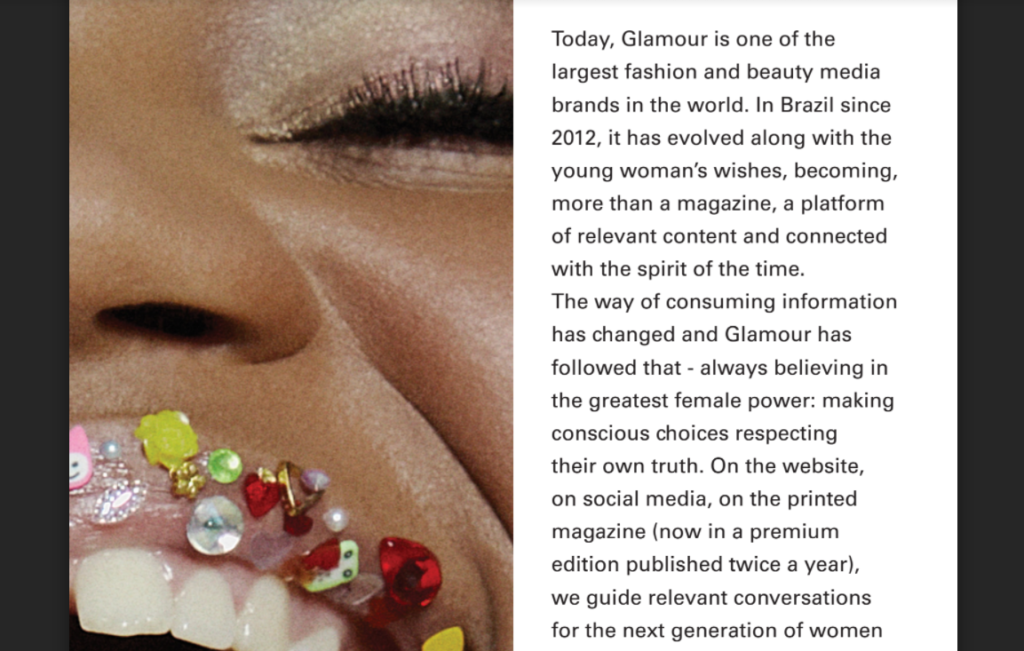
Think of this section like your brand’s elevator pitch. Who are you and what services do you offer? Potential advertisers should be able to use your media kit to determine whether or not your company mission statement reflects their values.
This is the part of your media kit that answers the question: Who are we and what do we do?
Audience Metrics
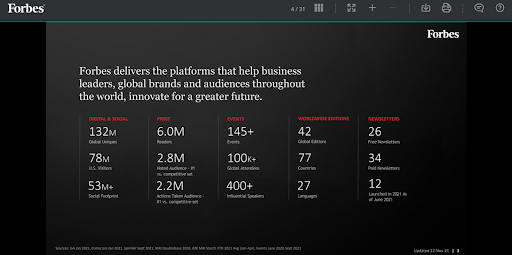
This is space to mention your digital and social channels, any print products, events, newsletters, and the audience reach of each. This is the key component of a publishing media kit, as it’s what conveys value to potential partners. The more impressive these numbers are, the higher your prices can be.
Your Brand Components
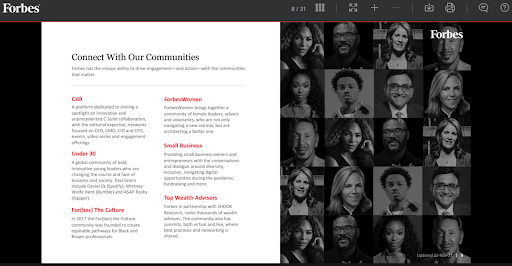
Publishers likely own multiple websites or digital properties that cater to multiple audiences, and each of these will be described in the media kit for advertisers to make the best choice of where, when, how, and to whom they want to advertise. You may also have a separate media kit for each offshoot, which also works.
Case Studies
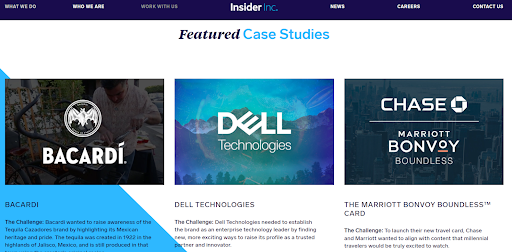
Call this the “FOMO” section (fear of missing out, for the uninitiated). This is a space where you can point to other brands that have successfully partnered with you and achieved great results. Advertising buy-ins have varying degrees of ROI and are always a risk. The purpose of a media kit should be to give as many concrete facts that assuage these concerns for your partners.
Ad Specs & Rate Card
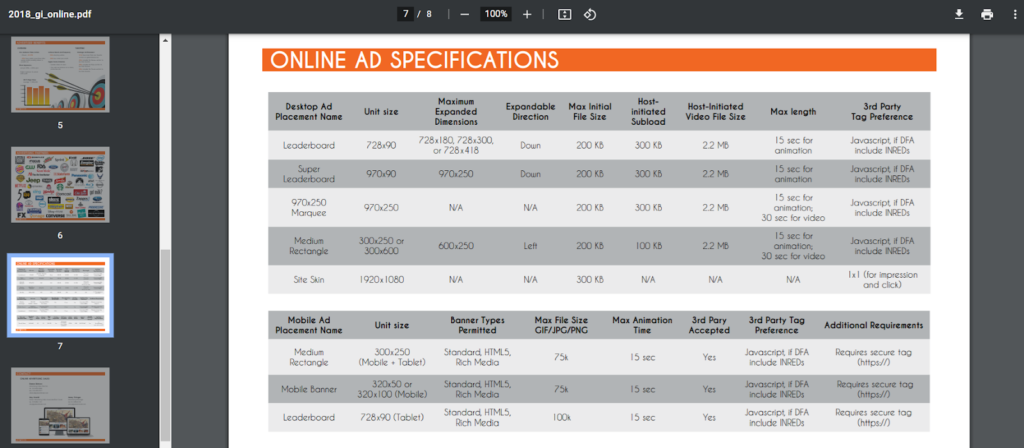
At the end of the day, the purpose of a media kit is to sell ad space and other paid opportunities. To do so, you need to clearly outline the types of opportunities that you offer, the media specs required for each, and—finally—your pricing rubric.
Yes, a “contact so-and-so for pricing” form works, too, but a) make sure it directs advertisers to a specific person, not a general helpline, and b) know that this approach might turn some partners off entirely. Full transparency is always best.
Check out examples of different media kits, including large and small publishers, in our list of best media kit examples.
How To Use A Media Kit
Any business or brand can use a media kit if they want to be intentional about drawing relevant advertisers to their platform. Advertisers may approach you or you may approach them. Either way, a media kit is a key component of this working relationship.
Make sure your media kit is everywhere. Online, print, email signature link, and PDF, for starters.
From here, you can send a pitch email to brands you want to work with and attach your media kit. You can print copies and take them to conferences in case you connect with a brand representative or fellow content creator. Have a QR code made that links out to it for the paper-adverse in-person partner. Go crazy.
You should also make your media kit readily available online. Advertisers should not have to “hunt” for this information—that’s a lost sale! A key purpose of a media kit is to promote accessibility and transparency.
Find out more about the steps and process to make a media kit in our post here.
Your Media Kit’s Effectiveness
So you made your very first media kit and have been pitching it to brands…and not hearing anything back. That’s a sign that something isn’t right. Check out more examples and a complete how-to list in this article to make sure that all your information is included and professionally displayed.
Ask yourself these 3 questions in the face of continued radio silence:
- Are my site metrics holding me back? If yes, focus on growing your community first. Hire a social media consultant. Do a site SEO audit. Pay for ads on other platforms.
- Is my brand mission statement clear? Perfect your elevator pitch and test it out on friends and colleagues. If who you are and what you do isn’t easily digestible, advertisers will walk.
- Is my media kit well designed? Your DIY approach to media kit design may be holding you back. The purpose of a media kit is to impress. It may be time to hire a professional designer or do a design overhaul if you already have one.
Once you have partnered with a brand, keep an eye on the metrics that matter to them! If you’ve gotten this far, you should already know how important they are, because they’re the whole reason an advertiser wanted to work with you in the first place. And in a successful partnership, both you and the brand you’re collaborating with should see increases.
To optimize your media kit’s effectiveness, ask for testimonials from satisfied advertising customers as well as comments and concerns from those who felt disappointed.
Related Read: Seriously, What Even Is A Niche Site? [Guide]
What Do You Think?
At the end of the day, the purpose of a media kit is to talk to potential advertisers. Predict the questions they are going to ask and answer them. Use cold, hard facts to back up your value as a partner and present it in a way that’s aesthetically pleasing and intuitive.
Did we cover everything you wanted to know about media kits? Have you used one and found it useful? Subscribe to the Indie Media Club newsletter for more on media kits and other topics in content creation and independent media publishing.
Related Read:
- 10 Best Website Content Optimization Tools To Outrank The Competition
- Advertising Networks For Indie Media Creators
Also Worth Checking Out:
